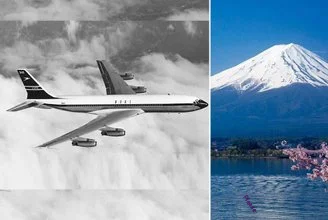Disturbing discovery on passenger's camera after tragic plane crash that claimed the lives of 124 individuals
On that ill-fated afternoon of March 5, 1966, tragedy befell British Overseas Airways Corporation's flight 911, known as Speedbird 911. Departing from Tokyo's Haneda Airport, the Boeing 707 passenger jet embarked on its journey to Hong Kong with 113 passengers and 11 crew members on board.
However, the serenity of the sunny skies quickly transformed into a nightmare as the aircraft encountered a devastating bout of turbulence near the majestic Mount Fuji. The six-year-old plane, soaring at a speed of 370mph to 425mph and an altitude of 16,000ft, was abruptly engulfed in a cloud of white vapor, signaling a rapid descent.According to the Motor, in a matter of minutes, the unthinkable unfolded before the eyes of horrified witnesses. The once sturdy Boeing jet succumbed to the merciless forces of nature, disintegrating into fragments that scattered across the sky. This catastrophic event claimed the lives of every soul on board, leaving behind a haunting legacy as one of the most catastrophic aviation disasters in history.
The Boeing's structure was shattered by an extremely powerful turbulence incident, a rare occurrence. The fuselage broke in half at 6,500ft, leading to a terrifying descent of the wreckage. The plane crashed into Mount Fuji's forests, resulting in a fiery explosion with no survivors. The debris was scattered over a 10-mile radius. Eerie images captured by the Japanese military depicted the jet's fatal descent.
According to the official crash report, the accident was likely caused by the aircraft encountering abnormally severe turbulence over Gotemba City, subjecting it to a gust load well beyond its design limit.
However, it was a chilling discovery among the belongings of a doomed passenger that provided the most haunting insight into the final moments experienced by the travelers.
One traveler had been recording the flight using an 8mm camera. The footage, which has never been released to the public, included scenes of the Tokyo airport and stunning aerial views of the mountain route.
However, crash investigators found that two frames were missing from the film, before it switched back to showing the backs of seats and the plane floor.
Experts have stated that a force of 7.5g would be necessary for the camera's mechanism to skip frames in such a manner. G forces exceeding 6 for an extended period can be deadly. The absence of frames indicated a harsh and violent fate for many passengers even before the plane crashed.
An issue of Flight International magazine, published in 1967 following the official crash report, mentioned: "Evidence from the wreckage and an 8mm color film shot by a passenger suggest that the aircraft disintegrated rapidly.
"The film clips displayed scenes of Tokyo Airport, the Tanzawa mountains, and Lake Yamanaka, followed by two blank frames, then images of passenger seats and/or a carpet before abruptly ending. Examinations revealed that a peak load of 7.5g was required to cause the film-feeding malfunction that resulted in skipping frames."
The crash of Speedbird 911 was one of four fatal airplane accidents in Japan that year - including one just a day prior at Haneda Airport, which claimed the lives of all but eight of the 72 individuals on board.
These crashes had a profound impact on the aviation industry of the country, sparking a movement for safety reforms that have significantly elevated standards over the years.






Comments
Post a Comment